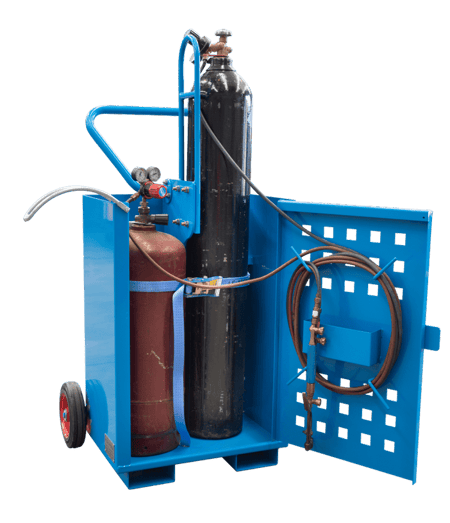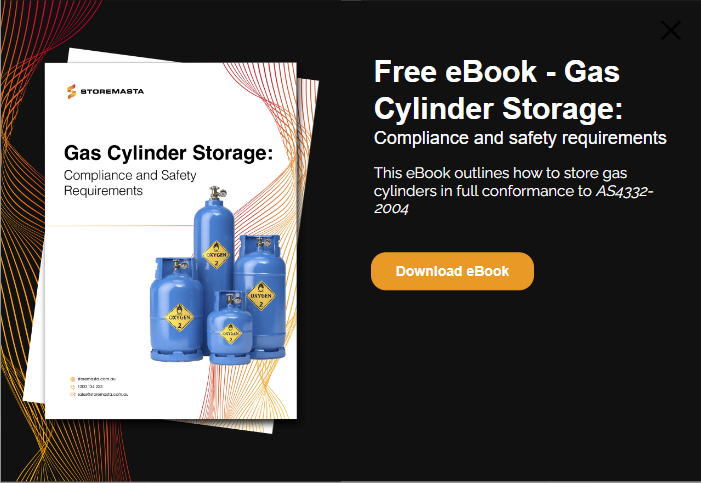As a team who have worked with customers across Australia and New Zealand to improve their chemical safety, you would be surprised how many times we see gas cylinders sitting around a jobsite without any proper storage. However, compressed gases in cylinders are recognised as dangerous goods, so the appropriate measures need to be taken to ensure that your staff, contractors — and even customers — are kept out of harm's way. In this post, we'll be looking at some of the hazards associated with these gases, as well as offering just 3 (of many!) reasons that you may need gas cages in your workplace.
Why Knowledge of Hazards and Risks is Vital for Safe Storage
Gases pose a range of risks specific to their chemical type. To understand the risks associated with your stores of gas, you must refer to your safety data sheet to fully understand the requirements for gas storage.
In addition to this, we highly recommend conducting an onsite risk assessment to identify and assess all the possible risks in your workplace. Afterall, it's likely that you may have potential hazards at your site - such as ignition sources or incompatible substances - which will affect the safety of your gases.
We'll look at some of these hazards in the next section of our blog.

Gas cylinder storage helps reduce the impact and likelihood of gas bottle hazards.
Chemical Hazards of Gas Bottles
Some types of compressed gases can pose hazards such as:
Class 2, Division 2.1 Flammable Gases
If these gases meet a source of ignition, such as a flame or spark, they can cause a workplace fire or explosion. Some flammable gases also have toxic properties, which can affect nearby personnel in the event of a fire or accidental release. Gases, such as LPG, may also displace air which can result in asphyxiation.
Class 2, Division 2.2 Non-flammable Non-toxic Gases
While Class 2.2 gases are recognised as non-flammable and non-toxic, they can still react with other substances - creating a hazard in workplaces that hold multiple classes of dangerous goods. Division 2.2 gases may also be classed as oxidising, which means that they may cause or contribute to the combustion of other material. Asphyxiation risk is another key concern when handling and storing non-flammable, non-toxic gases in the workplace, as these gases dilute or replace the oxygen present in the air.
Class 2, Division 2.3 Toxic Gases
Toxic gases, such as chlorine or sulphur dioxide, are a type of compressed gas that poses health risks to the people that work with them. Used in a range of applications from laboratories to refineries, these substances can quickly affect the health of staff if there is an accidental release.
Physical Hazards of Gas Cylinders
There are also physical risks associated with compressed gas in cylinders. If cylinders are dropped, damaged or subject to extreme heat or conditions, they can become projectiles. These heavy, metal gas bottles can cause extreme impact damage in a workplace. Bottles that aren't kept in gas bottle storage can create chaos when the gas is released. The weight and construction of the bottle, combined with the extreme force of the compressed gas releasing suddenly, can heavily impact both staff and property if they become airborne. The risk of serious injury or even fatalities occurring is very real in such a circumstance.
Storemasta's Gas Bottle Storage - Premium Range offers configurable storage for Class 2 Gases whether these are aerosols, bottles or gas cylinders. The rules of segregation still apply.
Therefore, as we've highlighted here, to ensure safety with gas bottles, you must consider both the chemical risks and the physical risk when considering storage.
3 Reasons to Install Compliant Gas Bottle Storage
As we've touched on in this post, there are ample risks that need to be controlled if you're working with any type of gas bottle or cylinder. Even seemingly innocuous substances can cause damage to workplaces that rely on them.
Gas cylinder storage should not ever be overlooked when you're working with these dangerous goods. Gas cylinder storage cages are the compliant way to store compressed gases, if you're looking for ready-made storage solutions.
Gas cylinder storage cages — otherwise known as gas bottle cabinets or gas bottle cages — need to feature a range of controls for them to be deemed compliant. This compliance requires that the gas bottle cages are designed and constructed to meet the stringent requirements of the Australian Standards.
If your gas bottle storage cages don't meet these requirements, then you may be risking site safety as well as non-compliance with WHS laws in your state or territory.
REMEMBER: You can read our blog on gas bottle storage requirements to learn more about the features of gas bottle cages.
However, choosing compliant gas cages for your site is the simplest and most effective way of reducing the likelihood and impact of gas cylinder hazards.
Let's look at just 3 key reasons that your site may require gas cylinder storage.
1. Gas Bottle Projectile Protection
Accidents can - and do happen. But if your cylinders are properly stored in compliant gas cylinder storage cages, then they won't cause destruction to your worksite if a rapid release of gas has been initiated.
Gas cylinder storage cages feature a heavy-duty steel construction, that can withstand the pressure of a rogue gas bottle. The gas cylinder storage has bolt-down plates, to secure the store in place and prevent damage.
The gas bottle cage is also equipped with a door bolt which can be padlocked. This further protects your workplace from the risk of projectiles, as well as unauthorised entry to gas bottle cages.
2. Natural Ventilation
Whether your gas cylinders are odourised for leak detection or you're dealing with compressed gases that are odourless, your workplace ventilation can greatly affect the impact of a gas leak or accidental release.
All gas cylinder cages and forklift gas bottle cages should be stored outside, to maximise the benefits provided by the ample natural ventilation of the units. Gas cylinder cages are constructed with ventilated sides and doors, and a solid steel roof and floor for strength.
This makes gas bottle storage cages an effective means of storing compressed gas cylinders due to the ample airflow provided by adequate ventilation.
This natural ventilation ensures that gases don't accumulate in low lying places within the storage equipment. It assists with helping the gases disperse from the storage area, which reduces the risk of asphyxiation and toxic gas poisoning, as well as dangerous reactions with incompatible substances, fire and explosion.
3. Stored Upright and Securely
In addition to these important controls, gas cylinders should always be stored in an upright position. The Australian Standard for compressed gases in cylinders explains that restraints are necessary in gas cylinder storage cages and forklift gas bottle cages.
To assist with this requirement, gas cylinder storage features sturdy restraints and chains to ensure the stability of gas cylinders. Gas cylinder storage cages assist with the prevention of damage occurring to gas bottles, as well as helping them to be secure and restrained. If a gas bottle falls over in storage, the cylinder may become punctured — or the valve may snap. This, in turn, will lead to the cylinder becoming unstable and possibly airborne due to the gas release.
Care must be taken to use the provided restraints to ensure that accidents like this don't occur in your workplace.
Caution is also required when receiving or moving gas cylinders around the worksite, as gas cylinders can become damaged (and dangerous) if they're left in any other position but upright. Handling equipment, such as a gas bottle trolley featuring restraints, is the preferable option for transporting your gas cylinders throughout your workplace.

Gas bottle safety includes compliant storage as well as handling equipment that keeps the bottle upright and secure.
Gas Cylinder Storage Cages and Your Workplace
Like to know more about protecting yourself against the hazards associated with gas cylinders in the workplace? Our eBook provides all the essential information including details from the Australian Standards, WHS Regulations and the necessary features of compliant gas cylinder storage cages. Get all the information you need on the safe storage of gas cylinders, by accessing your free copy of our eBook today.
Joining the team as a Dangerous Goods Storage Consultant, Melissa Hampton became Storemasta's Marketing Manager in late 2021. With extensive knowledge and experience in chemical compliance, Melissa is responsible for leading the Marketing team and helping shape their marketing strategy. In her spare time, you can find Melissa hiking, swimming and enjoying the great outdoors in beautiful north-west Tasmania.

